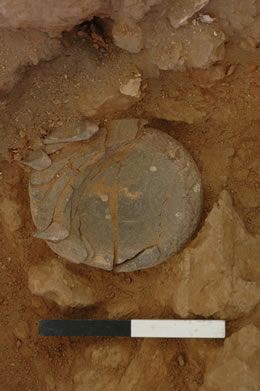GROUNDSTONE
Katherine I. (Karen) Wright and Adnan Baysal
In 2005, the methods and aims for the studies of ground stone artifacts at Çatalhöyük were refined and expanded, building upon those established earlier in the project. ‘Team Ground Stone,’ which since 2002 has been composed of Katherine (Karen) Wright and Adnan Baysal, engaged in several key activities in the summer of 2005.

Figure 36. One of the many stone objects, a stone mortar 11928.X 2, found on the floor of platform F.2174 in Building 52 (see also Fig. 16). |
Comprehensive study took place of the material from Building 3, excavated by the University of California at Berkeley (BACH), in preparation for the publication of this part of the project. All of the ground stone material from this house and its associated deposits was pulled out and the ground stone artifacts were systematically analyzed and the data entered into a working database for this house. In weekly meetings with the BACH publication team, we discussed aspects of ground stone technology, artifact use-life, spatial distribution, contextual analyses and relationships of the ground stone to other categories of finds and features. The draft of the chapter for this part of the publication will be submitted in early January 2006 and publication should follow some months thereafter. Provisional results indicate that the materials from House 3 are somewhat different from those of Building 1 and the 355 priority contexts.
Intensive studies of raw material properties, sourcing and lithic technologies are continuing, with particular focus on ground stone cores and debitage, manufacturing technology and discard. In particular, we organized the raw material reference collection from geological surveys of past years, into a more systematic study collection, and we began to refine our initial assessments of raw materials used for ground stone at the site. We also added to the petrological reference collection.
We are in the process of organizing analyses of residues recovered from ground stone tool surfaces in previous excavations. Samples of inorganic residues have been conserved for integration with other such studies, eg by the micromorphologists and archaeochemistry specialists on the project.
The artifact database of material from across the site is being added to and refined. We also held discussions about coordination and linking of the ground stone database to the central site database, with Mia Ridge (Museum of London), Ian Hodder and other teams. It is hoped to have full coordination very soon.
We spent several days in the Konya Museum, studying material excavated during the Mellaart years and we are very grateful to the Director of the Konya Museum for the permission to undertake this important work. The Mellaart material revealed some important surprises.